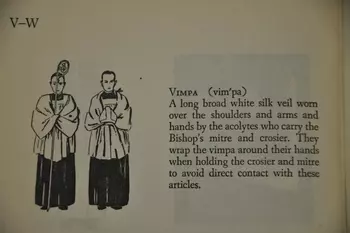
So What are Vimpae?
The Coat of Arms of Scharfenberger is embroidered on his vimpae. A gift to the Bishop from the Extraordinary Form Community of Albany.

The Coat of Arms of Scharfenberger is embroidered on his vimpae. A gift to the Bishop from the Extraordinary Form Community of Albany.
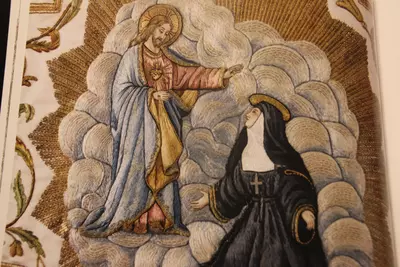
The Museum of the Visitation features stunning works of art produced, collected, and saved over many Centuries by the Order of the Visitation. The artworks include many ornamental branches of church art such as statues, silver, textiles, and silks.

Chalice veils are very simple to construct. The beauty of the finished piece lies in excellent workmanship construction techniques and appropriate design placement. The design of a chalice veil can be as simple or elaborate as the imagination allows. Although the chalice veils do not have any trim around the edge, it is appropriate to use a cord as a decorative finish at the seam. Chalice veils often have a cross motif placed on the front edge too.
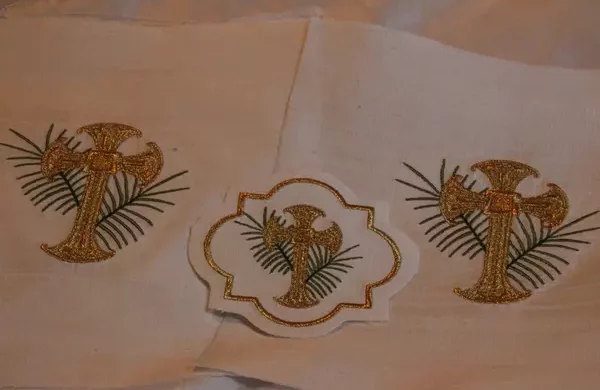
Using modern techniques to complete an Ecclesiastical Vestment set can be a lifesaver. The designs can often be modified in size to fit specific needs. The colors can often be selected to suit a particular occasion or color scheme. Selecting someone who is well versed in the Ecclesiastical Arts, as well as fluent with modern machine embroidery can be a delightful way to expand design possibilities for enhancing Ecclesiastical Vestments…

Using Rose Vestments during Advent and Lent varies among differing church bodies. The New Liturgical Movement has some information on the historical use of Rose Vestments within the Catholic Church. The Lutheran Church Missouri Synod’s view on Rose Vestments is slightly different. If a Rose Vestment Set is desired or planned for your church, be sure to check with your pastor or bishop concerning appropriate use and guidelines for liturgical colors.
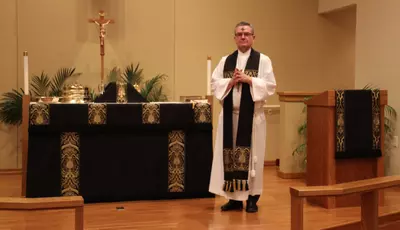
For this altar frontal, the plan is to use two 7″ orphrey bands on either side of the center front. There will be a solid space of white that will be about 9″ wide left between the orphrey bands. This band or space that was left would be adorned with a host of hand-embroidery designs. The project will have to be content with plain bands of white between the rows of orphreys.
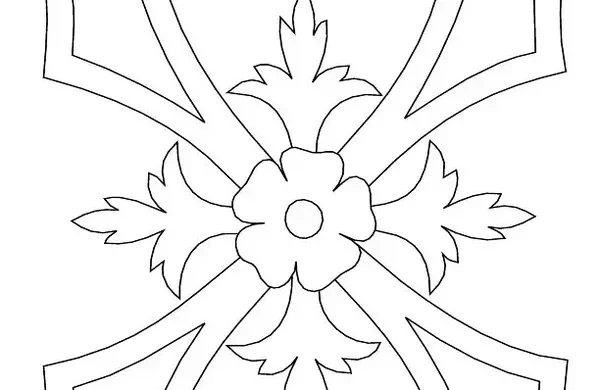
Vintage ecclesiastical embroidery patterns, mostly 100+ years old, delicate on aged paper. Fragile and creased, the paper poses challenges for fabric transfer; the slightest touch risks damage. Despite their impracticality in original condition, efforts are made to add new life. The best solution involves creating clean versions through scanning the original design, though it’s a challenging process.
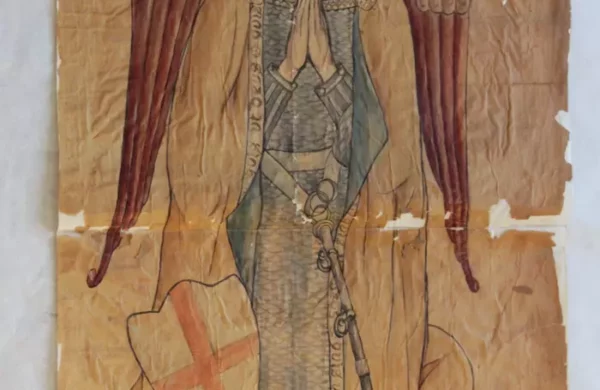
Collection of vintage Ecclesiastical Embroidery Designs, Drawings, and Patterns.
– The collection dates from the 1870s, and includes a wide variety of items, both in terms of content and quality, as well as size. The process of identifying the designs in the collection will take months. So, let us wait for the entire collection of Ecclesiastical Hand Embroidery Patterns to be cataloged.
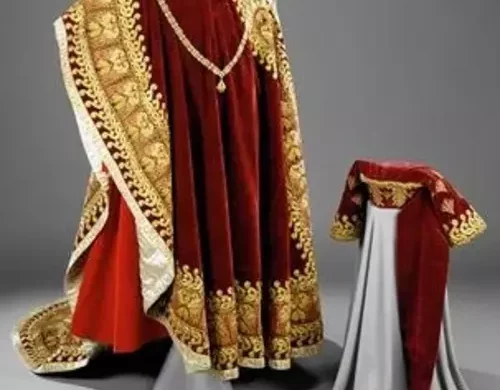
Featuring the Habsburg Splendor Exhibit at the Minneapolis Institute of Arts, a showcase of exquisite goldwork embroidery. Don’t miss some pieces, including suits of armor, tapestries, curiosities, and renowned paintings by artists like Caravaggio and Hans Holbein. Visit the intricate details on the Minneapolis Institute of Art’s webpage for a closer look at this splendid collection.

The orphrey trim for the chalice veil had been planned and cut to size and position based on the use of the black Passion Cross. The idea was to place the black motif on a gold motif so it would be more visible. The center of the orphrey was located and matched to the center of the design on the black Fairford Fabric.
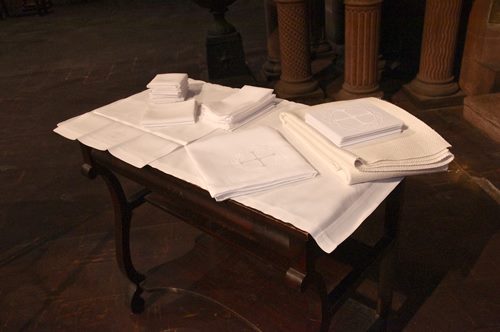
Making altar linens for the King of England – a very special project, coordinated by Elizabeth Morgan. Ecclesiastical Sewing small role in a historic event

Merge three vintage Ecclesiastical Embroidery Designs into a versatile artwork. The simple lines make it ideal for whitework, but it seamlessly transitions for gold and silk Ecclesiastical Embroidery. For whitework, consider stitches like stem stitch, outline stitch, and padded satin stitch for letters. Alternatively, use outline stitch with seed stitch fill. Chainstitch is another excellent choice for whitework in Ecclesiastical Embroidery.
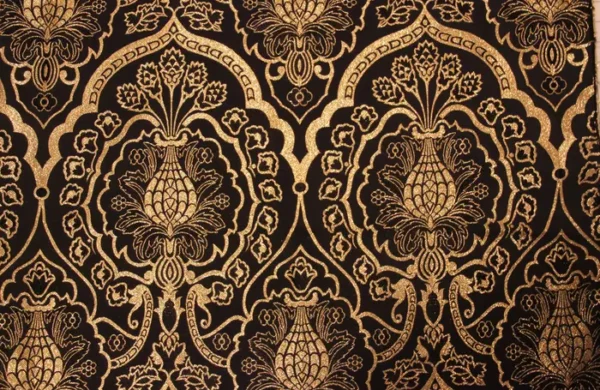
Ecclesiastical Brocatelle fabric for the Ash Wednesday and Good Friday Vestment set has a pattern repeat. But not a tiny, regular pattern repeat. It is a whopping 17″ pattern repeat. There is a tiny arrow at the point or peak of the gold border which is an Ogee pattern. This fabric also has a pattern repeated on the width which is easily determined by measuring the distance between the two black dots located at the base of the gold frame.
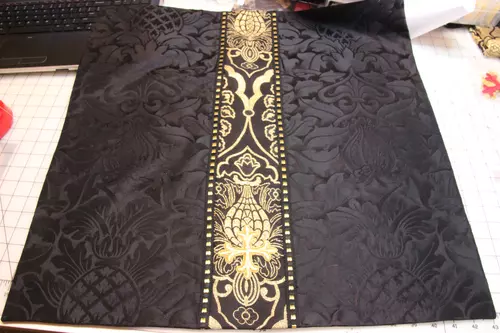
Making the Chalice Veil – a simple item to make is a chalice veil. The dimensions of the chalice veil can vary. The size used for my church is 24″ square. To keep the project simple, a plain fabric can be selected, But for now lets take a look pattern designs in the Fairford, there are two main motifs: the Pineapple and the Ogee. The pineapple motif was selected as the central motif on this chalice veil. The two crossed pins mark the center of the pineapple. The pattern design in Fairford makes it easy to match the same motif point to obtain straight and even lines for cutting.
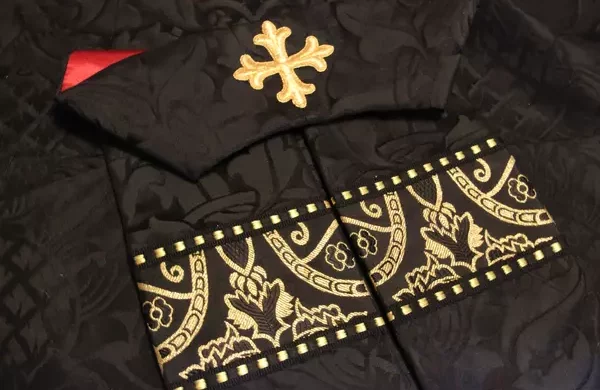
Ash Wednesday Altar Frontal and Chalice Veil Ecclesiastical Sewing Project.
You must be logged in to post a comment.